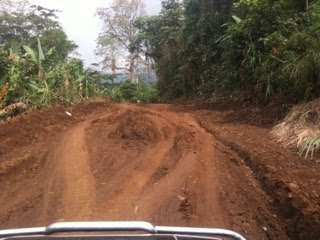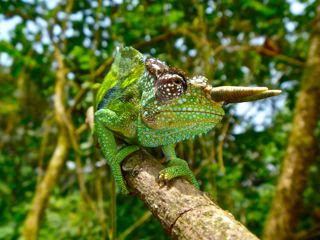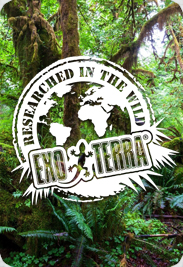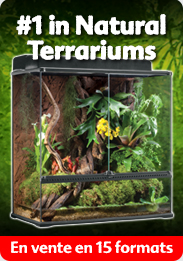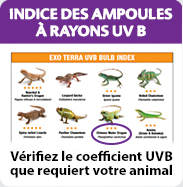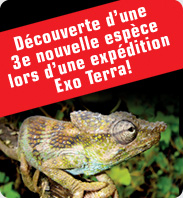Expédition 2010 - Cameroun / L’expédition en Afrique tribale
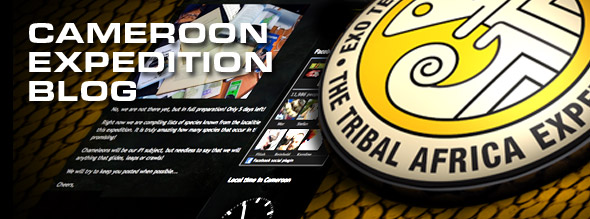
Back in Europe!
After travelling together for nearly 3 weeks, the members of the Exo Terra expedition team all went their separate ways. Some of us are travelling to the US, Canada and Germany...We can all look back to a successful expedition! Maybe we all expected to see more variety in reptiles and amphibians, but our main goal of
mapping the Chameleon fauna is certainly reached. We have seen all species we expected to see!
Stay tuned for the images on our Facebook page!
Cheers,
All of us...
Last leg!
Right now we are on our way back to Douala. It was a very successful expedition and we nearly saw everything we hoped for! On top of that we have several new records as well! More later, I hope to post some more images when back in Douala...Trioceros serratus
Some images of Trioceros serratus from the Mount Oku area. One of the most colourfull species we encountered during this expedition...Trioceros quadricornis gracilior
Some more image as promised from T. quadricornis gracilior and from the field measurements taken...Manebgouba Mountain
Breathtaking scenery near the the Manengouba lakes...On our way to Bakossi Mountains
Today we drive back south to the Bakossi Mountains area, the last leg of our expedition.
We have been very successful this far when it comes to finding Chameleons, but we have seen very few other species of reptile or amphibians...
Hopefully this will change when we explore the lowland forests... We will keep you posted.
Trioceros serratus
Just done photographing T. serratus, beautiful animals... Some good pictures later...Trioceros quadricornis gracilior from Mount Oku
Good morning from Mount Oku, Cameroon. Yesterday was a great day where we again found what we were looking for; Trioceros quadricornis gracilior and Trioceros serratus. Here are already some images of the T. quadricornis, the other species will follow later... Later today we will go back to the sacred forest where we found most T. quadricornis gracilior yesterday, but first we will photograph the T. serratus.We now found all montane and submontane species of chameleon. The only species of which we did not really found full adult specimen is Troceros quadricornis quadricornis. Also an adult female of T. pfefferi would complete our records... We now will head back south in an attempt to find these before descending to the lowland forest to search for T. oweni and T. cristatus. We have a little to find T. camerunensis... Since we do not have the time to visit the localities of T. eisentrauti and T. wiedersheimi, we probably have to organize a second expedition to cover all currently known species in Cameroon.
More picture later today...
On top of Mount Oku
Yesterday after a full say driving on one of Cameroon's worst roads we reached the town of Kumbo. Now searching for chameleons... Hopefully some pictures soon!Mount Oku
Finally we see Mount Oku in the distance... Hopefully we reach there before dark, the road is getting worse again...Bamboutos
Driving through the Bamboutos region, in the background Mount Bamboutos. As you can see there is no forest left at all... We continue towards Mount Oku...Entering Mbouda...
On our way to Mount Oku... Just stopping in Mbouda to try and change some money, then on our way to Bamenda where we will have lunch... Hoping to arrive before darkness near Mount Oku.Dschang
Rainy day! It rained all night last night, and it still is... Cold night as well, we lit the fireplace in our hut, and forgot we were actually in tropical Cameroon... Today we will decide on our next destination, as the planned Bamboutos mountains have very little forest left... You will hear from us soon!Some more chameleon shots...
Hi everyone, time for some more Chameleon pictures! Great expedition so far... Today we head for Dschang. More news soon!Manengouba Mountains
Right now in the Manengouba Highlands (1770m) where we just found a pair of Trioceros perreti! Great looking animals, more images later...On Mount Koupe!
Right now on Mount Koupe (1550m) in search of T. quadricornis quadricornis and T. pfeferi. This was the toughest journey so far!!! Hopefully we find some...Rough road!
Almost there, not so easy!On our way to Mount Kupe
This morning we left Mount Cameroon an now we are heading for Kupe... More news soon!Some chameleon shots...
Finally we are able to share some Chameleon shots we took over the past two days on mount Cameroon! W hop hope you enjoy them, even they are rather small because of the poor internet connection. We hope to post more soon!Back down...
We made it back safe down the mountain!!! It was though for some of us... Loren and Guy here near the waterfall were we found 6 chameleons... Great expedition so far, tomorrow we head Mount Kupe...Cheers
At 1400m!
Rewarding trip up the mountain... Again several specimen of T. montium... Right now filming some close ups.Up on Mount Cameroon again!
The climb seem to be tougher then yesterday, but I guess we still have yesterdays ascent in our legs!!! We found our first T. montium already at 8:45 am this morning... Our Chris Anderson is now busy to capture this great looking male on an SD card... More images soon, still a 1000m vertical climb ahead of us... Now I need to rehydrate!T. montium
We found 17 t. montium today!!! One of them this incredible male! What a successful dag today... Tomorrow we will be back up mount Cameroon again!Mount Cameroon...
This afternoon we reached Mount Cameroon which we are now climbing up to the primary rain forest! We just found our first Trioceros montium female!!! Pictures soon. This mountain is steep!Mount Cameroon...
This afternoon we reached Mount Cameroon which we are now climbing up to the primary rain forest! We just found our first Trioceros montium female!!! Pictures soon. This mountain is steep!Le Cameroun
Le Cameroun est un pays du golfe de Guinée situé à la rencontre de l’Afrique centrale et de l’Afrique occidentale. Le Nord du Cameroun est sec et couvert de vastes savanes, alors que le Sud regorge de forêts tropicales humides denses. Le Cameroun est très riche du point de vue écologique et culturel. On y retrouve en effet plus de 200 groupes ethniques ainsi qu’une biodiversité impressionnante.
La géographie du Cameroun est l’une des plus diversifiées de l’Afrique et se divise en trois zones principales : la savane du Nord, les forêts tropicales humides du Sud et de l’Est, et les régions montagneuses du Nord-Ouest, situées près du Nigéria. En raison de sa grande diversité géographique et culturelle, on surnomme parfois le Cameroun « l’Afrique miniature ». Ses précieuses forêts tropicales humides recèlent de nombreuses espèces d’arbres dont le palmier à huile, le palmier bambou, l’acajou, le teck, l’ébène et l’hévéa. Il abrite une faune variée et abondante qui comprend entre autres des chimpanzés, des gorilles, des antilopes, des lions et des éléphants, de même que de nombreuses espèces d’oiseaux, et évidemment, de reptiles et d’amphibiens. Forêts tropicales humides étouffantes de chaleur, réserves fauniques, fiers sultans et poulet grillé : le Cameroun est sans contredit l’un des pays d’Afrique les plus diversifiés, autant par sa nature que par sa culture. Par ailleurs, le mont Cameroun est non seulement la plus haute montagne d’Afrique de l’Ouest, mais il est également le seul volcan encore actif de toute l’Afrique.
Explorez les forêts tropicales du Cameroun avec Exo Terra. Jusqu’ici, trois nouvelles espèces de reptiles ont été découvertes au cours de ces expéditions. Les données recueillies permettent à la communauté scientifique et aux spécialistes de conservation d’en apprendre davantage sur les reptiles et les amphibiens, et ainsi d’assurer l’avenir de ces derniers. Une meilleure connaissance de leurs comportements dans la nature permet à nos équipes de recherche et de développement de mieux comprendre les besoins de ces animaux et de savoir en prendre soin adéquatement en captivité.







































